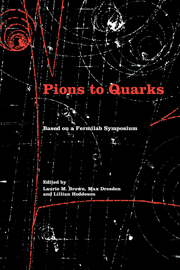Book contents
- Frontmatter
- Contents
- List of contributors
- Foreword by Leon M. Lederman
- Editors' acknowledgments
- Photographs of the symposium
- List of abbreviations
- List of notation
- I Introduction
- II Particle discoveries in cosmic rays
- III High-energy nuclear physics
- IV The new laboratory
- V The strange particles
- VI Weak interactions
- VII Weak interactions and parity nonconservation
- VIII The particle physics community
- 34 The postwar political economy of high-energy physics
- 35 The history of CERN during the early 1950s
- 36 Arguments pro and contra the European laboratory in the participating countries
- 37 Physics and the excellences of the life it brings
- 38 Social aspects of Japanese particle physics in the 1950s
- IX Theories of hadrons
- X Personal overviews
- Name index
- Subject index
35 - The history of CERN during the early 1950s
Published online by Cambridge University Press: 07 May 2010
- Frontmatter
- Contents
- List of contributors
- Foreword by Leon M. Lederman
- Editors' acknowledgments
- Photographs of the symposium
- List of abbreviations
- List of notation
- I Introduction
- II Particle discoveries in cosmic rays
- III High-energy nuclear physics
- IV The new laboratory
- V The strange particles
- VI Weak interactions
- VII Weak interactions and parity nonconservation
- VIII The particle physics community
- 34 The postwar political economy of high-energy physics
- 35 The history of CERN during the early 1950s
- 36 Arguments pro and contra the European laboratory in the participating countries
- 37 Physics and the excellences of the life it brings
- 38 Social aspects of Japanese particle physics in the 1950s
- IX Theories of hadrons
- X Personal overviews
- Name index
- Subject index
Summary
Introduction
The history of CERN is of considerable interest, not only for highenergy physics but also more generally, because CERN is the first example of an intergovernmental research laboratory created in Europe that has been operated successfully for more than thirty years – a remarkable model for the creation of international organizations.
Armin Hermann, with the help of a few younger historians, is preparing a complete history of CERN in two volumes.* From this extensive presentation, John Krige of Hermann's group, with the help of his colleagues, will extract a more concise CERN history, contained in a single volume of 300 pages and addressed to a wider public.
My account here is of a completely different nature. I did not consult the archives of the foreign ministries or of the research councils of the member states of CERN or of other intergovernmental organizations. The material here is based on a few well-known documents, on my personal diary of that period, and on a few reports and lectures prepared years ago by Lew Kowarski or by me.
Everyone agrees that the early history of CERN can be divided into three periods. The first period encompassed the first initiatives and extended from the middle of the 1940s to 15 February 1952. On that date, the representatives of eleven European governments signed in Geneva the agreement established ing a provisional organization with the aim of planning an international laboratory and organizing other forms of cooperation in nuclear research.
- Type
- Chapter
- Information
- Pions to QuarksParticle Physics in the 1950s, pp. 508 - 518Publisher: Cambridge University PressPrint publication year: 1989



